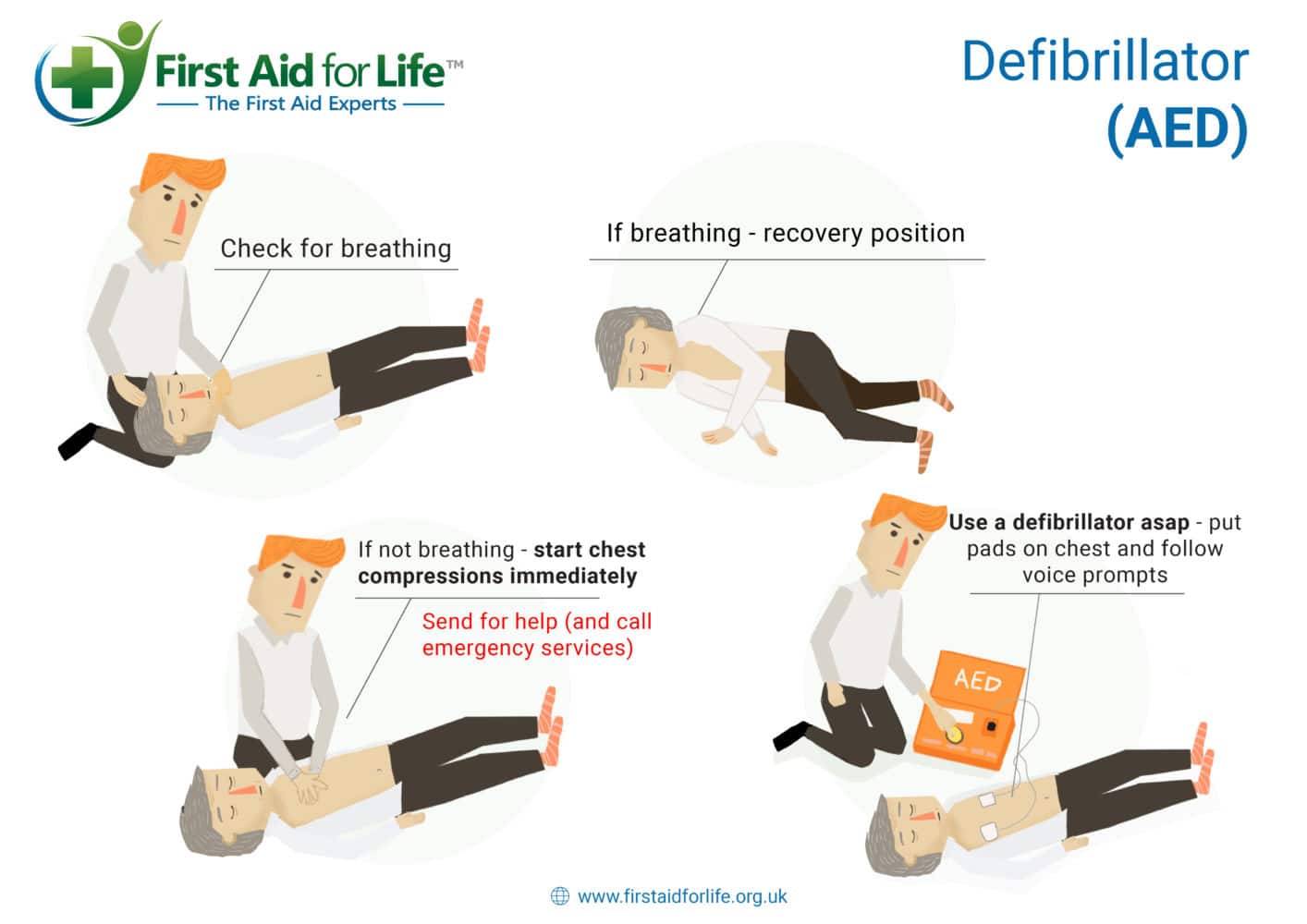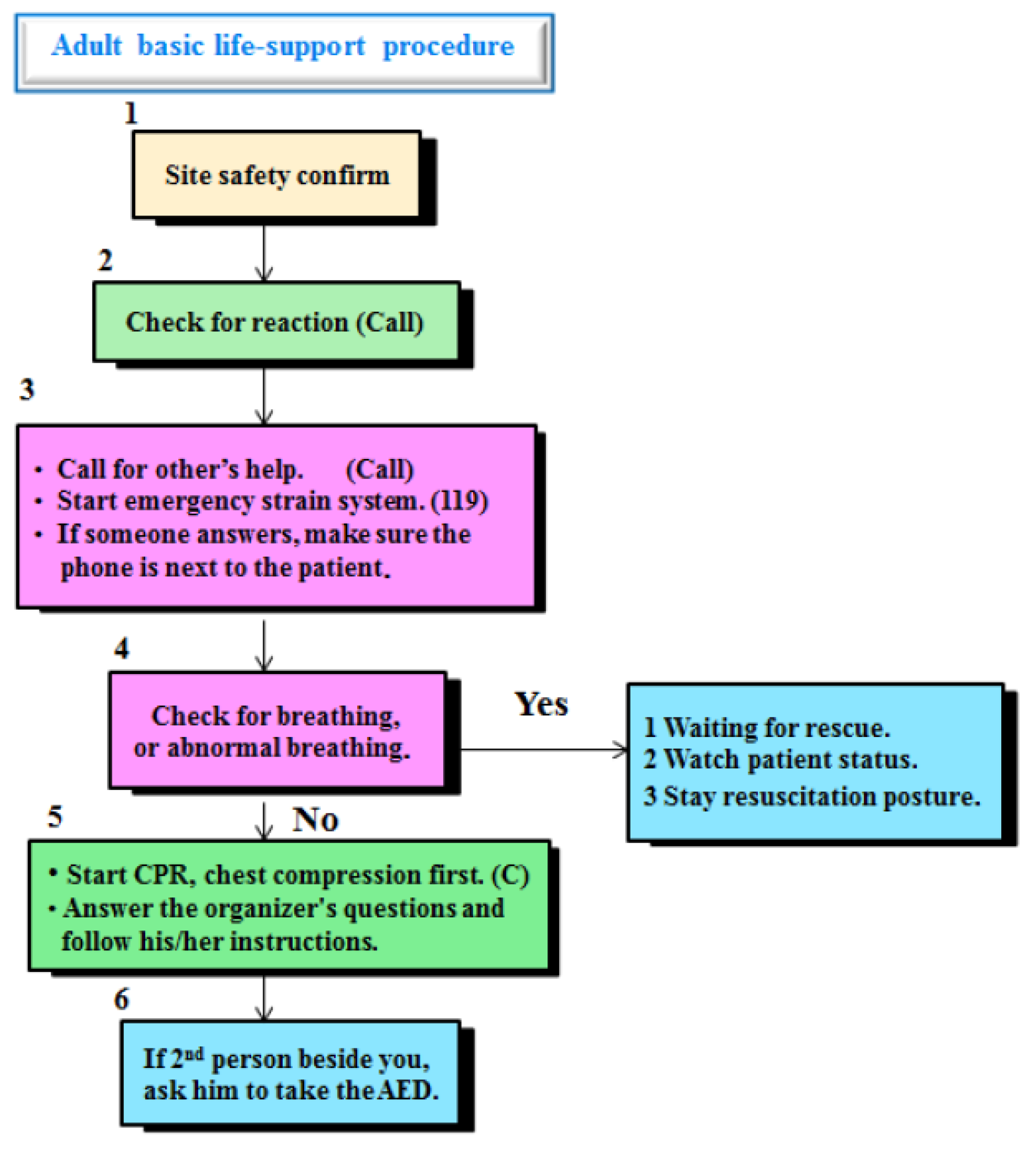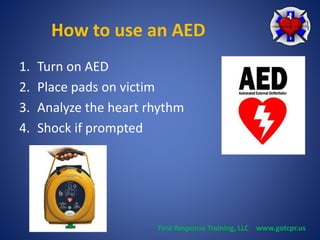An Aed Should Be Used on a Non Breathing Victim
An AED can be used on anyone aged over a year old but adaptations are needed when using an AED on a child. 20 minutes on 30 off and 20 on again.

Refresh Kembali Materi Acls Mu You Can Save A Life Jadidokter Com
To control severe bleeding.

. A Only if CPR does not work. An AED should be used on a non-breathing victim seen to collapse suddenly-as soon as possible ASAP First aid for a serious burn includes-Putting a loose dressing on the burn after cooling it. It should never be used on a patient suffering a heart attack who is still conscious and breathing.
These AED steps should be used when caring for an adult or a non-breathing child age eight or older who weighs more than 55 pounds. An automated external defibrillator should only be used on someone suffering sudden cardiac arrest presenting as unconscious and not breathing. For children aged one to eight years old paediatric pads should be used.
However an AED is crucial towards regaining the natural rhythm of the heartbeat as. AED use is indicated if a person collapses and is unresponsive and not breathing. 100 compressions per minute.
The Red Cross offers OSHA-compliant AED training certification programs but they also created a quick step-by-step guide to help workplaces review the AED steps whenever necessary2. They do not require an AED shock. It is important to know that sometimes victims of Sudden Cardiac Arrest in this state may demonstrate agonal breathing for seconds to minutes after their heart has stopped beating.
Most drowning victims will have sustained cardiac arrest secondary to. B As soon as possible. For an adult use AED immediately for no signs of life and.
When to apply an AED to a patient. To control severe bleeding-put direct pressure on the wound. Generally speaking an AED should be used when a person is unconscious not responsive and not breathing properly.
Cardiac arrest can be fatal if not treated within minutes. Steps to using an AED. CPR should be performed if the patient is non-responsive and not breathing and an AED should be applied after performing CPR.
AED should be used on a non-breathing victim seen to collapse suddenly. However statistics demonstrate that the average EMS call to shock time time from the 911 call to having an AED at the side of the victim is between 6 9 minutes and depending on the city and differing circumstances can be longer. When should an AED be used on a non breathing victim.
An automated external defibrillator. Put direct pressure on the wound. As soon as possible.
These AED steps should be used when caring for a non-breathing child aged 8 or older who weighs more than 55 pounds or an adult. Correct ratio of compressions to breaths in CPR. C After calling 911 waiting for EMS dispatcher to tell you to use it.
How to Use An AED. What is the procedure for using ice on a sprained ankle. At least 2 inches.
An AED Should be Used on a Non-breathing Victim seen to Collapse Suddenly. 1Turn on the AED and follow the visual andor audio prompts. An AED should be used on a nonbreathing victim who collapsed suddenly.
AEDs are designed to be used by non-medical personnel such as firefighters police officers lifeguards flight attendants security guards. After checking the scene and ensuring that the person needs help you should ask a bystander to call 911 for help then. Put direct pressure on the wound.
Determine if victim is choking by asking. Victims of Sudden Cardiac Arrest may demonstrate agonal breathing for seconds to minutes after their heart has stopped beating. AEDs Automatic External Defibrillators when used within the first 3-5 minutes of a person suffering a Sudden Cardiac Arrest SCA can dramatically increase a victims chance of survival from currently what is currently less 5 to as much as 70 and higher with a defibrillator on the scene.
As soon as possible. Ideally the victim should be treated by trained EMS personnel with an AED within the 5 minute window. These AED steps should be used when caring for a non-breathing child aged 8 or older who weighs more than 55 pounds or an adult.
First aid for a serious burn includes. However an AED is crucial towards regaining the natural rhythm of the heartbeat as well as restarting the patients heart. A shock from an AED is typically only delivered in about 12 of the victims in this condition but with high-quality CPR the heart may need a shock when the condition of the heart changes.
AED should be used on a non-breathing victim seen to collapse suddenly. AEDs were designed to be used by virtually anyone with little or no experience. D After giving abdominal thrust for choking.
When is the only time you should move an unresponsive victim. Cooling it with cool running water. Depth of chest compression in cpr for an adult.
First aid for a serious burn includes. After checking the scene and ensuring that the person needs help you should ask a bystander to call 911 for help then. To control severe bleeding.
An AED should be used on a non breathing victim seen to collapse suddenly and only after youve taken this action. CPR is a very important action when saving a patients life. An AED should be used on a non breathing victim seen to collapse suddenly.
Putting a loose dressing on the burn after cooling it. Although the rhythm deterioration in drowning is usually to a non- shockable rhythm the AED may be lifesaving in 6 of drowning victims who on initial assessment are found to have a shockable cardiac rhythm. If paediatric pads are not available use the standard ones but place one pad in the centre of the childs chest and the other one in the centre of the childs back.
Do you do CPR on a drowning victim. 1 Complete the CHECK and CALL steps. FAQs qnadmin December 21 2021.
When should an AED be used on a child who is not breathing. Use of the AED Dry the victims chest before applying pads. If an adult or a child is in cardiac arrest not responsive not breathing and no pulse you should begin cardiopulmonary resuscitation CPR with chest compressions and yell for someone to call 911 and get an AED.

Cpr For Infant Child And Adults Safety Training Training Center Cpr

How To Perform Cpr And Use An Aed

Introduction To Cardiopulmonary Resuscitation And Use Of An Aed

Part 4 Adult Basic Life Support Circulation

Aed For Surviving Sudden Cardiac Arrest

Airsep Focus Portable Oxygen Concentrator Oxygen Concentrator Portable Oxygen Tanks

Newlife Elite Oxygen Concentrator 5 Liter Oxygen Concentrator Oxygen Medical Prescription

Use Aed Step By Step Guide Alsco Com Au

Paeds Bls 2020 Emergency Response System Pediatrics Septic Shock

Ijerph Free Full Text What Do Adolescents Learn From A 50 Minute Cardiopulmonary Resuscitation Automated External Defibrillator Education In A Rural Area A Pre Post Design Html

Ijerph Free Full Text What Do Adolescents Learn From A 50 Minute Cardiopulmonary Resuscitation Automated External Defibrillator Education In A Rural Area A Pre Post Design Html

First Aid For Someone Who Is Unresponsive And Not Breathing When An Aed Is Available

Australian Resuscitation Council Releases New Guidelines Relating To Basic Life Support And Cpr Http M Basic Life Support Nursing Supplies First Aid Course

Basic Life Support Algorithm Aed Is Automated External Defibrillator Download Scientific Diagram

History Of Cpr Cpr Select Infographic Cpr Cpr Classes Cpr Poster

Cpr Or Aed First Aid Tips On What To Do Cpr Steps

20 While The Aed Analyses The Heart Rhythm Nobody Should Touch The Download Scientific Diagram
